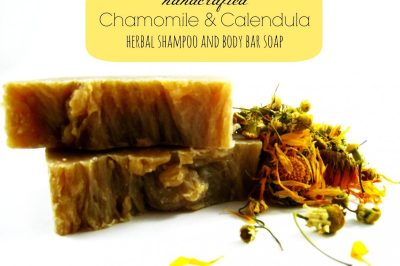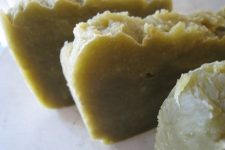Dry.
Sensitive Scalp.
Calm.
Heal.
Nourish.
This shampoo & body bar was created to heal the scalp and calm inflamed, sensitive skin. Not to mention, it’s perfect for lighter hair colors!
Calendula…
…according to HerbWisdom.com, calendula “contains plant constituents, which have been shown in animal studies to speed up wound-healing by several actions that include increasing blood flow to the affected area and promoting the production of collagen proteins. Calendula also possesses anti-septic and anti-inflammatory effects due to its flavonoid content.”
…likewise chamomile flowers are known to “soothe skin rashes (including eczema), minor burns and sunburn. Used as a lotion or added in oil form to a cool bath, chamomile may ease the itching of eczema and other rashes and reduces skin inflammation. It may also speed healing and prevent bacterial infection.”
What a great soap to make and share with almost anyone!
California Sunshine Shampoo & Body Bar Soap
Ingredients
Oils
- 8 ounces coconut oil
- 8 ounces olive oil
- 8 ounces organic, sustainably-sourced palm oil
- 4 ounces shea butter
- 2 ounces cocoa butter
- 3 ounces castor oil
Liquid
- 10 fluid ounces water or a handmade calendula and chamomile water infusion, click here to learn how to make an herbal water infusion
- 4.52 ounces lye (7% excess fat)
Add-Ins
- 2 teaspoons calendula flower powder
- 1 teaspoon chamomile flower powder
- 2 ounces jojoba oil
- 1-2 ounces essential oil blend of lemongrass, sweet orange, lemon, and/or bergamot
Soap-Making Basics
*Thanks to the Internet and amazing people who are willing to share their wisdom so freely…I was able to learn the skill. I primarily use the hot processed method…however, choose the method you feel most comfortable with:
- Wardeh, who runs Gnowfglins, on her personal blog Such Treasures gives the clearest, most easy to follow directions ever! This is the exact post that got me started. She uses the hot processed method and I highly recommend that you read her recipe if you are even the slightest bit interested in making your own soap.
- Renee of Fimby was also very inspirational and such a great resource! Watch her awesome video that describes the cold processed method for making a simple soap by clicking here.
If you are new to soap-making, I strongly suggest you read through these very informative articles and find what will work for you:
I would also recommend borrowing a few of these books from the library if you really find yourself wanting to know more:
- Handcrafted Soapby Dolores Boone
- The Soapmaker’s Companionby Susan Miller Cavitch
- The Natural Soap Book by Susan Miller Cavitch
Hot Process Method
*Remember…there are 2 different methods for soap-making — hot and cold process — this is the Hot Process Method.
- Measure both the lye and water (or herbal infusion if using) – each in separate bowls — using a kitchen scale. Note: Always run your recipe through a lye calculator to be sure that you are using the proper amount of oils, lye, and liquid.
- Carefully combine the lye and liquid by pouring the lye into the liquid (never pour liquid into the lye) and stir liquid until lye is completely dissolved. The liquid is caustic and not to be touched in any way. The outside of the bowl will be extremely hot as well. Be careful when working with lye and follow all of the recommended precautions. Note: What I’m trying to say is, I can not be held responsible for any craziness, mishaps, explosions, etc. that may happen when making this recipe.
- Allow the lye mixture to stay under a vent and cool down while you prepare the oils.
- Measure the oils – by weight – and then place in a crock pot to melt on low heat. Please omit the essential oils and jojoba oil…we will be adding them later.
- Once melted, add the lye/water mixture to the oils in the crock pot and stir. Note: Any equipment the lye touches needs to be neutralized in a mixture of white vinegar, soap, and water.
- After a brief stir, grab your stick blender and get to work! Blend the oils and liquid in the crock pot for at least 1-2 minutes. We are working toward “trace.”
- After 1-2 minutes, add the herbal powders. Using a wire whisk, whisk until well combined.
- Continue whisking for 2-3 minutes more – until the mixture becomes a thick, pudding like consistency.
- Once the mixture is pudding-like, cover the crock pot and “cook” the soap, on low heat, for approximately 1 hour.
- Prepare your mold. Note: I just use a standard loaf pan lined with parchment paper and it’s always worked perfectly and this recipe is enough to fill one loaf pan.
- Once the soap is done “cooking” remove from heat and quickly add the essential oils and jojoba oil.
- Stir until well combined.
- Spoon soap mixture into mold.
- Allow soap to cool and harden for 24 hours.
- Remove from mold on to cutting board and cut into bars.
- Place bars on a tray with good airflow so that they can harden further. But feel free to go ahead and use your first bar!
Where Can I Get This Stuff
–Starwest Botanicals…they have everything you’ll need by way of Bulk Herbs, Organic Oils & Butters, and Natural Products for Healthy, Natural Living! It’s your one-stop-shop!
–Mountain Rose Herbs & The Bulk Herb Store also carries many of these ingredients if you’d like to price check.
-I also just love the people over at The Soap Dish. You can purchase lye and other ingredients necessary for this recipe.
Not ready to DIY soap?
This handcrafted California Sunshine Herbal Shampoo Bar
can be purchased in my Etsy Shop
by clicking this link.
I thank you for your love and support of quality handmade products!
DISCLOSURE: In order for me to support my knowledge-sharing/writing/blogging activities, I occasionally may receive monetary compensation for my endorsement, recommendation, testimonial and/or link to any products or services from this article. However, I only recommend products or services I have personally used myself and trust.





 Rosemary Mint Herbal Shampoo & Body Bar
Rosemary Mint Herbal Shampoo & Body Bar
I have never thought of using calendula in shampoo. I’ve only used in skin care products like creams before. Thank you for the interesting idea.
This would be really great, if it weren’t for the fact that there is no such thing as sustainably-sourced palm oil. Demand keeps growing and growing for palm oil and vegans are using it in butter substitutes even, it’s become a health food fad. But the reason it isn’t sustainable is because the Roundtable on Sustainable Palm Oil (RSPO) has members that have been caught red-handed harvesting in at-risk areas. This behavior proves them to be nothing more than a front group. More and more people are catching on and noticing that while this hugely impacts the Orangutans, it also is pushing the Clouded Leopard and at least two types of bears as well as other wildlife towards extinction rapidly! Please consider going palm oil free. If we work on education about this dangerous health and body care trend we may end the suffering going on.
What would you suggest to use instead? Everything you said makes sense and I would like to know if there is an alternative.
I suggest using pastured lard or tallow – it is sustainable, in a lot of cases it is local, and it is showing respect to the animal by using parts of it that would be considered waste by all but a few. Here is a great blog post about why using tallow or lard in soap is a good idea.
http://www.humblebeeandme.com/why-i-use-lard-or-tallow-in-my-soap-and-why-you-should-too/
And thank you Andrea for posting this soap, because of a recipe you posted before, I harvested all of the calendula in my Grandma’s yard (which was a whole lot!) and made an infusion of it in some olive oil, I’ve been adding it for the olive oil portion in my facial bars. Thank you for sharing your knowledge!
I too, have a concern with using palm oil and have tried tallow. It is not the same at all in the end product, and in addition fat stores toxins. Those toxins are then in your soap. Do you know of another less toxic alternative?
Hello, there are almost two months now that I am on your site and I have NEVER RECEIVED YOUR FREE EBOOK.
Would this be a problem sending your site or forget … it is certain that I still have not received anything to date.
Thank you and continue your work, I love your website because I learn things that allow me to become a little more independent.
Are you signed up to receive emails from Frugally Sustainable? It is always on every email I receive from Andrea toward the bottom half of the email.
You must have read my mind. I was thinking about making shampoo bars for brunettes for the holidays and a friend asked if I could make some for blondes, too. Thanks for the inspiration!
That recipe sounds absolutely LOVELY, and perfect for wintertime!!
can you do this as a cold process and if so what changes?
Hi Andrea, thanks so much for the recipe. I’ve been looking for a shampoo for blondes for a long time. I was wondering about the palm oil. The only palm oil I could find is red. Is that correct? I certainly don’t want my hair turning completely red! :). I would appreciate a quick response. I so anxious to make the shampoo this week if possible. Thanks so much!